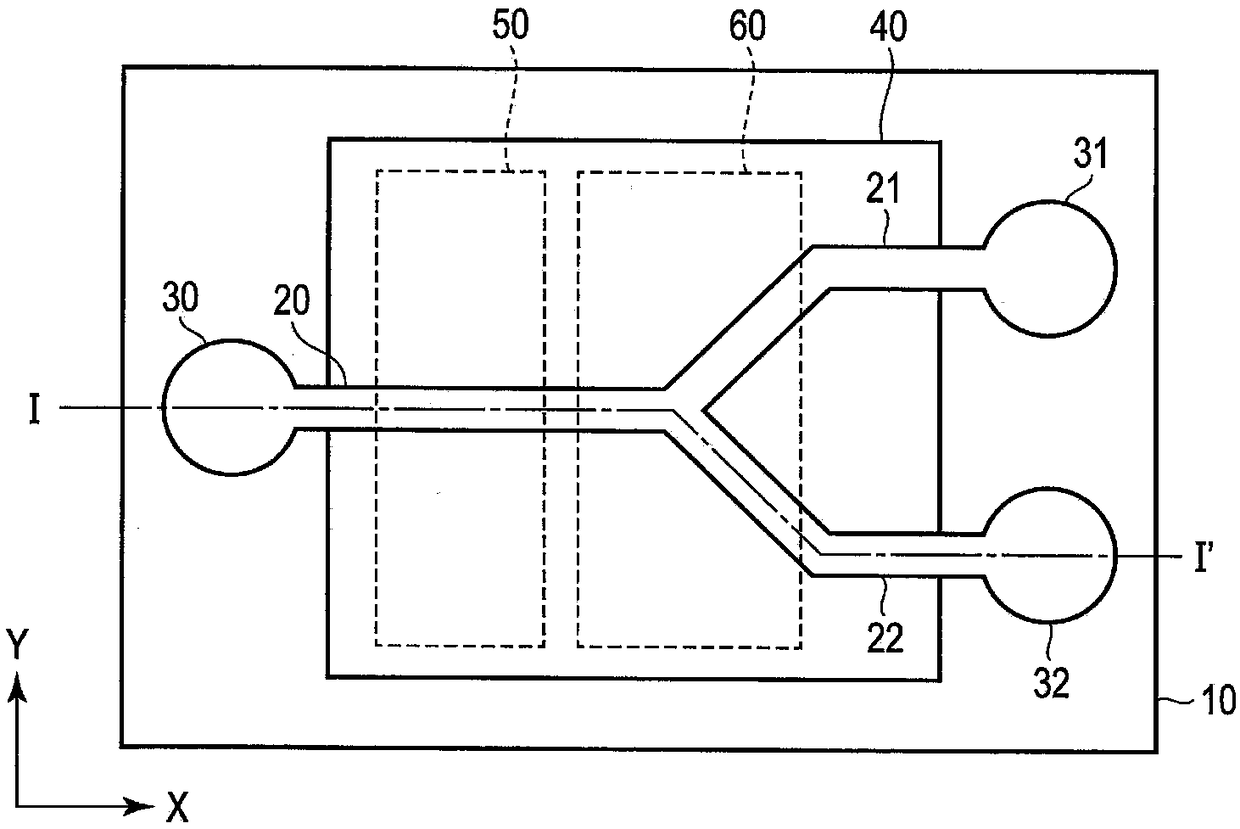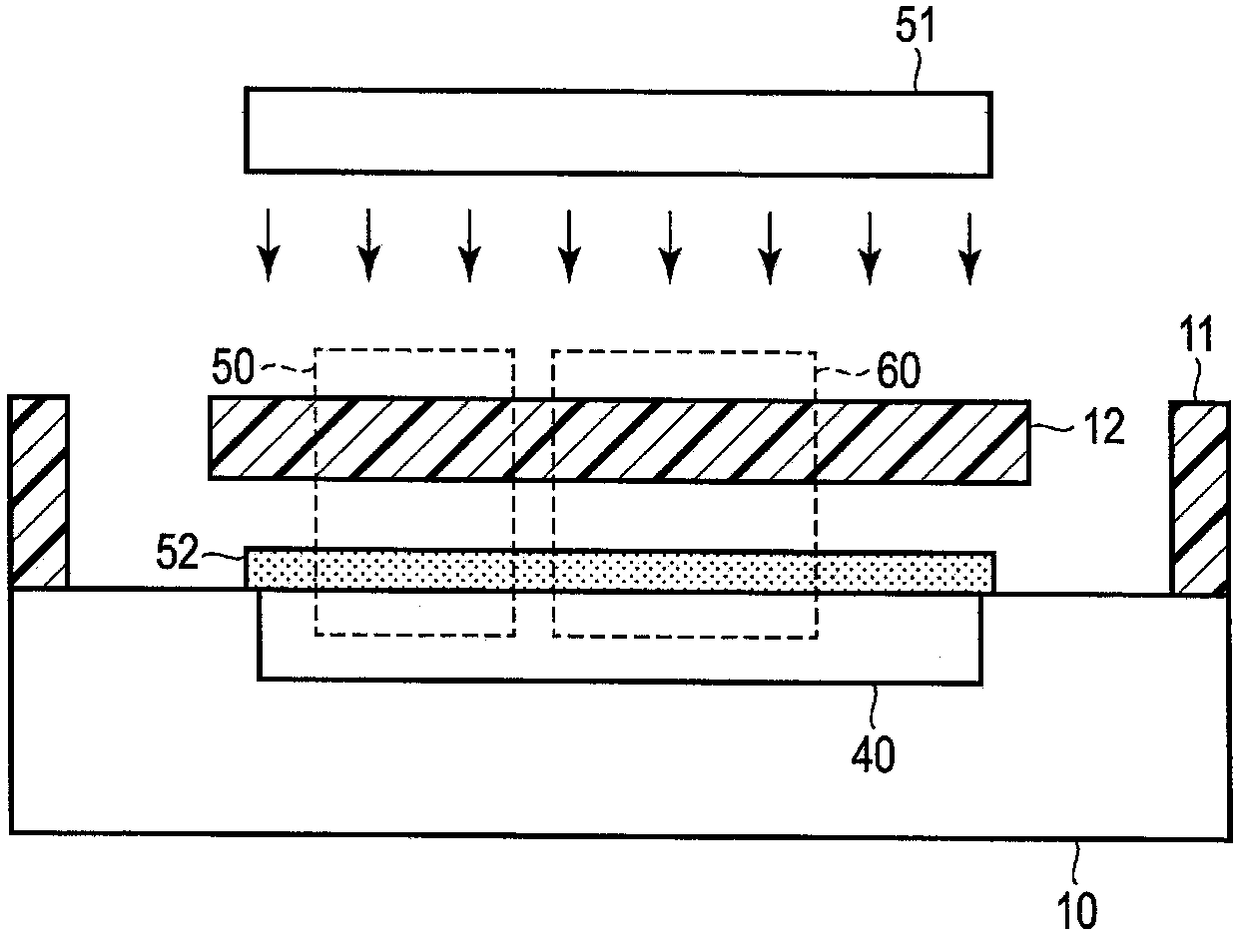Cell sorter
A sorter and cell technology, applied in the field of cell sorters, can solve the problems of inability to observe sorting, low processing capacity of sorting, and cell damage.
- Summary
- Abstract
- Description
- Claims
- Application Information
AI Technical Summary
Problems solved by technology
Method used
Image
Examples
no. 1 Embodiment approach
[0038] figure 1 and figure 2 is a diagram for explaining the schematic configuration of the cell sorter according to the first embodiment, figure 1 is a top view, figure 2 yes figure 1 The I-I' section view.
[0039] A flow path structure 11 made of resin such as PDMS (polydimethyl siloxane) is stacked on a substrate 10 such as a semiconductor substrate based on Si or glass epoxy. By selectively etching this channel structure 11, a channel (first channel) 20, branch channels (second channels) 21, 22, an input unit 30, and output units 31, 32 are provided. The upper surfaces of the respective flow paths 20 , 21 , and 22 are covered with a cover 12 made of the same material as the flow path structure 11 . In addition, the lid body 12 may be formed by embedding a sacrificial layer in the flow paths 20 , 21 , and 22 , depositing a thin film, and removing the sacrificial layer.
[0040] The flow channel structure 11 and the cover body 12 may be any material as long as it tr...
no. 2 Embodiment approach
[0062] Figure 6 It is a plan view showing a schematic configuration of the cell sorter according to the second embodiment. Additionally, for figure 1 The same parts are denoted by the same reference numerals, and detailed description thereof will be omitted.
[0063] This embodiment differs from the first embodiment described above in that a plurality of cell sorter elements having the same configuration as the first embodiment are arranged in a row.
[0064] A first cell sorter element 100 including a channel 20 , branch channels 21 and 22 , an input unit 30 , output units 31 and 32 , a determination unit 50 , and a separation unit 60 is provided on the substrate 10 . A second cell sorter element 200 having the same configuration as the first cell sorter element 100 is provided separately from the first cell sorter element 100 in the Y direction. The image sensor 40 is formed across a plurality of cell sorter elements 100, 200 so as to cover the flow path 20 of the first ...
no. 3 Embodiment approach
[0070] Figure 7 It is a plan view showing a schematic configuration of the cell sorter according to the third embodiment. Additionally, for figure 1 The same parts are denoted by the same reference numerals, and detailed description thereof will be omitted.
[0071] This embodiment differs from the previously described first embodiment in that a second-stage cell sorter element is provided at a subsequent stage of the first-stage cell sorter element having the same configuration as that of the first embodiment.
[0072] The channel (first channel) 20 of the primary cell sorter element, the first branch channel (second channel) 21, 22, the input unit 30, the first determination unit 50, and the first fractionator The part 60 is the same as that of the first embodiment. One end side of the second-stage re-branched flow path (third flow path) 21a, 21b is connected to the other end side of the first-stage branched flow path 21, and the other end side of the re-branched flow pa...
PUM
 Login to View More
Login to View More Abstract
Description
Claims
Application Information
 Login to View More
Login to View More - R&D
- Intellectual Property
- Life Sciences
- Materials
- Tech Scout
- Unparalleled Data Quality
- Higher Quality Content
- 60% Fewer Hallucinations
Browse by: Latest US Patents, China's latest patents, Technical Efficacy Thesaurus, Application Domain, Technology Topic, Popular Technical Reports.
© 2025 PatSnap. All rights reserved.Legal|Privacy policy|Modern Slavery Act Transparency Statement|Sitemap|About US| Contact US: help@patsnap.com



